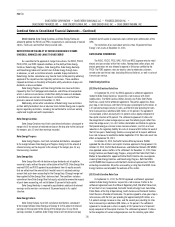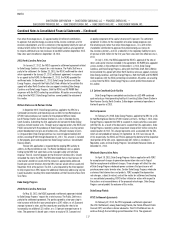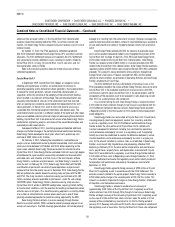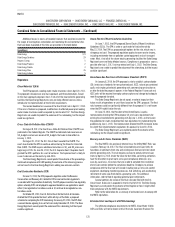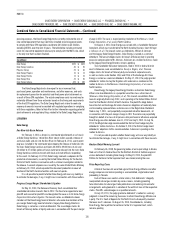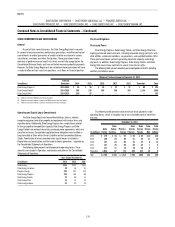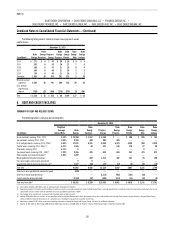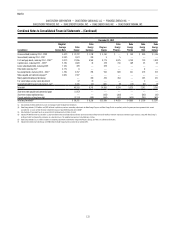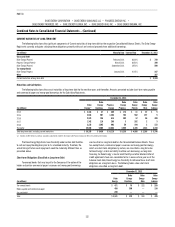Duke Energy 2013 Annual Report Download - page 143
Download and view the complete annual report
Please find page 143 of the 2013 Duke Energy annual report below. You can navigate through the pages in the report by either clicking on the pages listed below, or by using the keyword search tool below to find specific information within the annual report.
125
PART II
DUKE ENERGY CORPORATION • DUKE ENERGY CAROLINAS, LLC • PROGRESS ENERGY, INC. •
DUKE ENERGY PROGRESS, INC. • DUKE ENERGY FLORIDA, INC. • DUKE ENERGY OHIO, INC. • DUKE ENERGY INDIANA, INC.
Combined Notes to Consolidated Financial Statements – (Continued)
Additional losses in excess of recorded reserves that could be incurred for
the stages of investigation, remediation and monitoring for environmental sites
that have been evaluated at this time are presented in the table below.
(in millions)
Duke Energy $74
Duke Energy Carolinas 29
Progress Energy 5
Duke Energy Progress 2
Duke Energy Florida 3
Duke Energy Ohio 35
Duke Energy Indiana 5
Regulations
Clean Water Act 316(b)
The EPA proposed a cooling water intake structures rule on April 20, 2011.
The proposed rule advances one main approach and three alternatives. Based
on the main approach proposed, most, if not all of the steam electric generating
facilities the Duke Energy Registrants own are likely affected sources unless
retired prior to implementation of the 316(b) requirements.
The revised deadline for issuance of the nal 316(b) rule is April 17, 2014.
If the rule is nalized as proposed, modications to affected power plant cooling
water intake structures could be required by mid-to-late 2017. The Duke Energy
Registrants are unable to predict the outcome of this rulemaking, but the impact
could be signicant.
Cross-State Air Pollution Rule (CSAPR)
On August 8, 2011, the nal Cross-State Air Pollution Rule (CSAPR) was
published in the Federal Register. The CSAPR established state-level annual
SO2 budgets and annual seasonal NOx budgets that were to take effect on
January 1, 2012.
On August 21, 2012, the D.C. Circuit Court vacated the CSAPR. The
court also directed the EPA to continue administering the Clean Air Interstate
Rule (CAIR). The CAIR requires additional reductions in SO2 and NOx emissions
beginning in 2015. On June 24, 2013, the U.S. Supreme Court (Supreme Court)
granted the EPA’s petitions for a writ of certiorari. The Supreme Court is likely to
issue its decision on the merits by mid-2014.
The Duke Energy Registrants cannot predict the outcome of the proceedings.
Continued compliance with CAIR pending the outcome of the rehearing process
will not result in the Duke Energy Registrants adding new emission controls.
Coal Combustion Residuals (CCR)
On June 21, 2010, the EPA proposed a regulation under the Resource
Conservation and Recovery Act, related to CCR or coal combustion byproducts
associated with the generation of electricity. The EPA proposal contains two regulatory
options whereby CCRs not employed in approved benecial use applications would
either (i) be regulated as hazardous waste or (ii) continue to be regulated as non-
hazardous waste.
On October 29, 2013, the U.S. District Court for the District of Columbia
directed the EPA to provide the Court, within 60 days of the Order, a proposed
schedule for completing the CCR rulemaking. On January 29, 2014, the EPA led
a consent decree agreeing to issue the nal rule by December 19, 2014. The Duke
Energy Registrants cannot predict the outcome of this rulemaking, but the impact
could be signicant.
Steam Electric Effluent Limitation Guidelines
On June 7, 2013, the EPA proposed Steam Electric Efuent Limitations
Guidelines (ELGs). The EPA is under a court order to nalize the rule by
May 22, 2014. The EPA has proposed eight options for the rule, which vary in
stringency and cost. The proposed regulation applies to seven waste streams,
including wastewater from air pollution control equipment and ash transport
water. Most, if not all of the steam electric generating facilities the Duke Energy
Registrants own are likely affected sources. Compliance is proposed as soon as
possible after July 1, 2017, but may extend until July 1, 2022. The Duke Energy
Registrants are unable to predict the outcome of the rulemaking, but the impact
could be signicant.
Greenhouse Gas New Source Performance Standards (NSPS)
On January 8, 2014, the EPA proposed a rule to establish carbon dioxide
(CO2) emissions standards for new pulverized coal, IGCC, natural gas combined
cycle, and simple cycle electric generating units commencing construction on
or after the date the proposal appears in the Federal Register. Future coal and
IGCC units will be required to employ carbon capture and storage technology to
meet the proposed standard.
The Duke Energy Registrants do not expect a material impact on their
future results of operations or cash ows based on the EPA’s proposal. The nal
rule, however, could be signicantly different from the proposal. It is not known
when the EPA might nalize the rule.
On June 25, 2013, the President of the United States issued a
memorandum directing the EPA to propose CO2 emissions requirements for
existing fossil-fueled electric generating units by June 1, 2014, and to nalize
the guidelines for states to develop their own regulations for implementing the
guidelines by June 1, 2015. The memorandum directed the EPA to require states
to submit their implementation regulations for approval by June 30, 2016.
The Duke Energy Registrants are unable to predict the outcome of this
rulemaking, but the impact could be signicant.
Mercury and Air Toxics Standards (MATS)
The nal MATS rule, previously referred to as the Utility MACT Rule, was
issued on February 16, 2012. The nal rule establishes emission limits for
hazardous air pollutants from new and existing coal-red and oil-red steam
electric generating units. The rule requires sources to comply with emission
limits by April 16, 2015. Under the Clean Air Act (CAA), permitting authorities
have the discretion to grant up to a one-year compliance extension, on a
case-by-case basis, to sources that are unable to complete the installation
of emission controls before the compliance deadline. Strategies to achieve
compliance with the nal rule will include installing new air emission control
equipment, developing monitoring processes, fuel switching, and accelerating
retirement of some coal-red electric-generating units. For additional
information, refer to Note 4 regarding potential plant retirements.
Several petitions for review of the nal rule were led with the D.C.
Circuit Court. A decision is expected in the rst half of 2014. The Duke Energy
Registrants cannot predict the outcome of the litigation or how it might affect
their compliance with the MATS requirements.
Refer to the table below for a summary of estimated costs to comply with
the MATS regulations.
Estimated Cost and Impacts of EPA Rulemakings
The ultimate compliance requirements for MATS, Clean Water 316(b),
CCRs and ELGs will not be known until all the rules have been nalized. For



